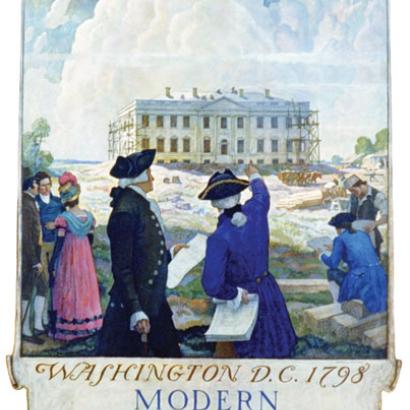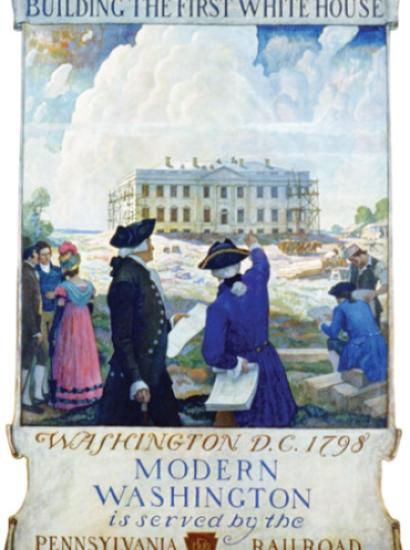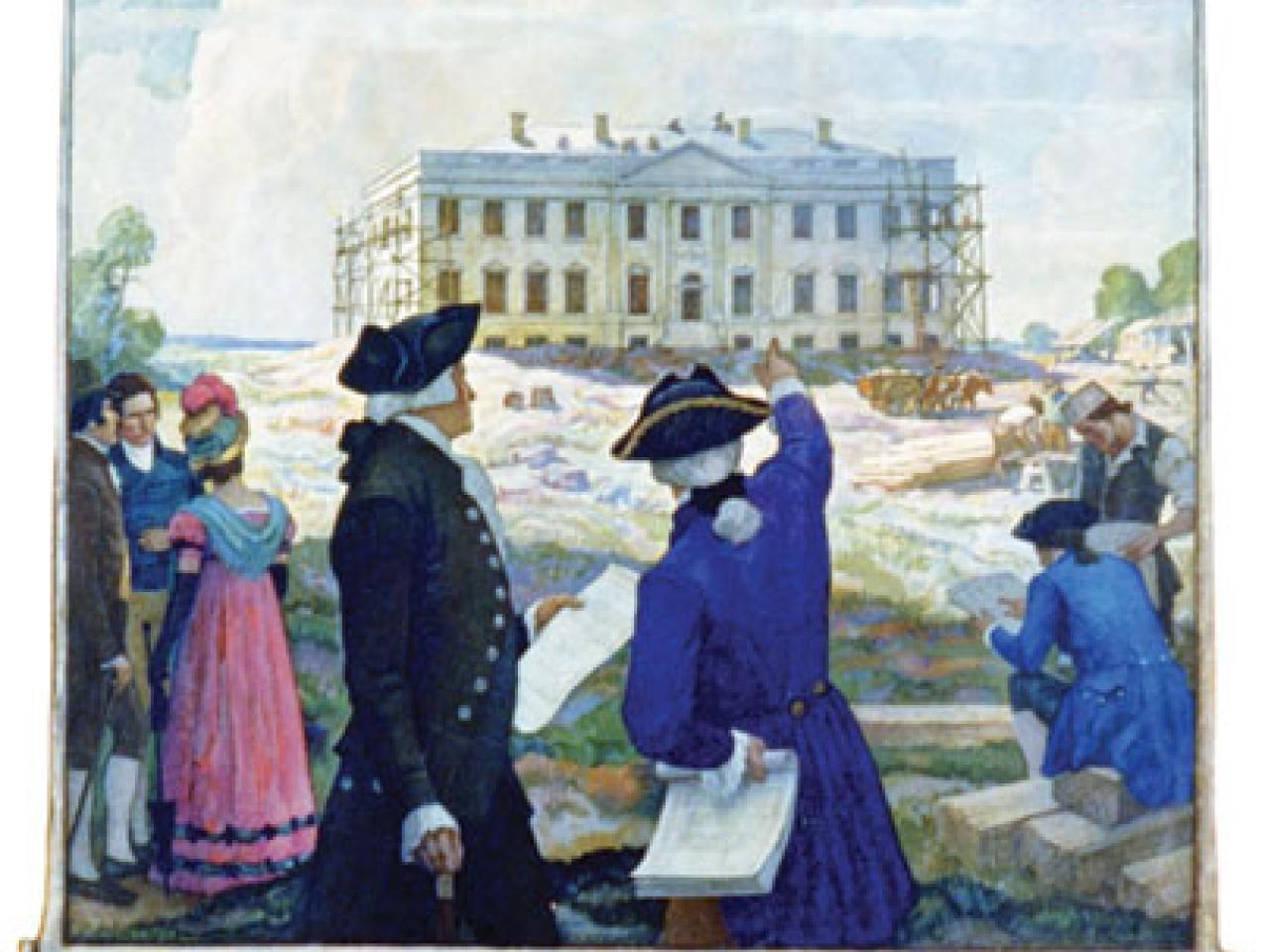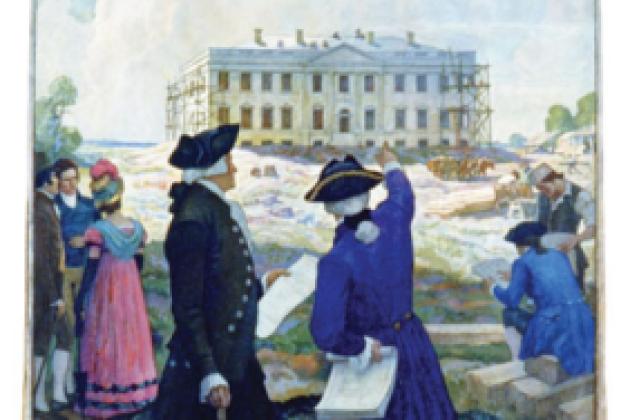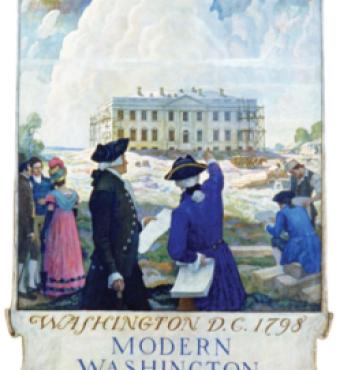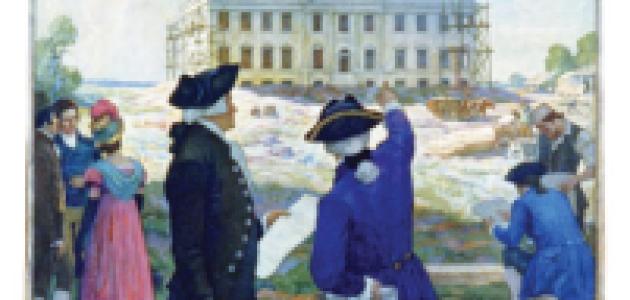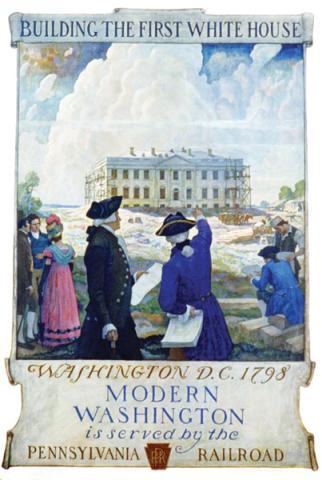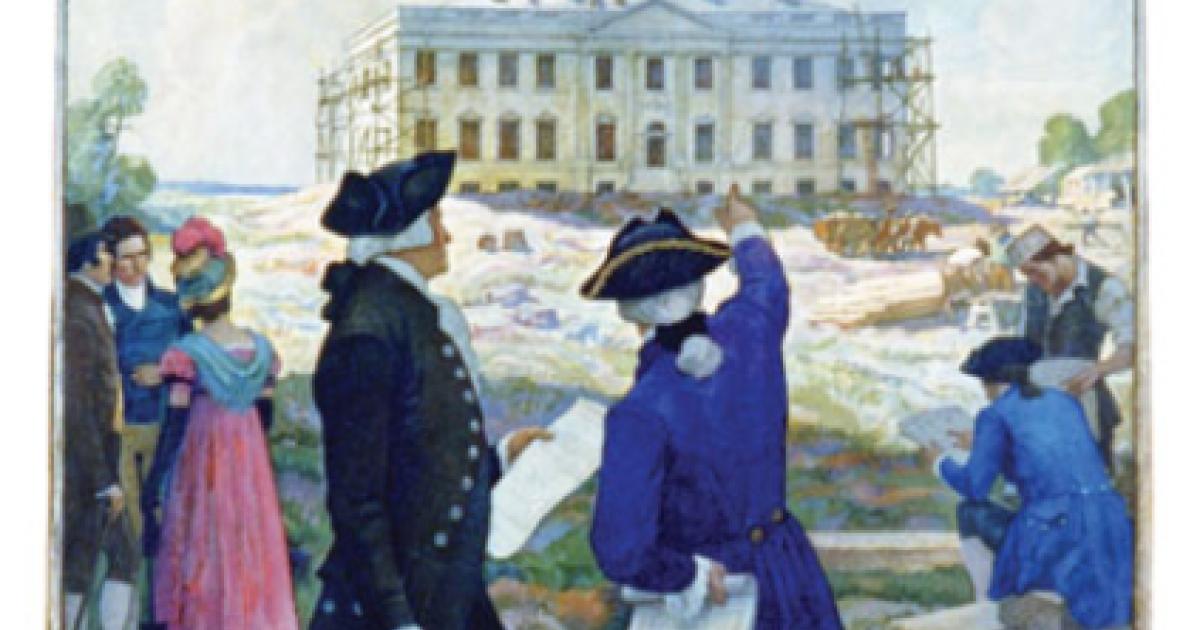- US
- World
- The Presidency
- History
- Politics, Institutions, and Public Opinion
As the forty-fourth president of the United States begins to build a new administration and chart his new course for America, it seems fitting to take a closer look at one of the 100,000 historic posters in the Hoover Institution Library and Archives. Building the First White House, painted by N. C. Wyeth for the Pennsylvania Railroad Company, depicts George Washington overseeing construction of the presidential mansion with its architect, James Hoban. This view of the White House, set against a magnificent and even portentous cloudscape, brilliantly blends the expectations of the historic figures with the modern knowledge that history has validated their hopes. Although two centuries separate the event depicted and the latest inauguration, the same sense of anticipation prevails.
The cover of this issue of the Hoover Digest is also a poster with a fascinating story—mystery story might be a more accurate description—for the painting from which the poster was made is lost, and despite the best detective efforts of curators, scholars, collectors, attorneys, and even the White House itself, its whereabouts remains unknown. The poster that survives in the Hoover Archives and other collections offers the only way to see what the painting looked like.
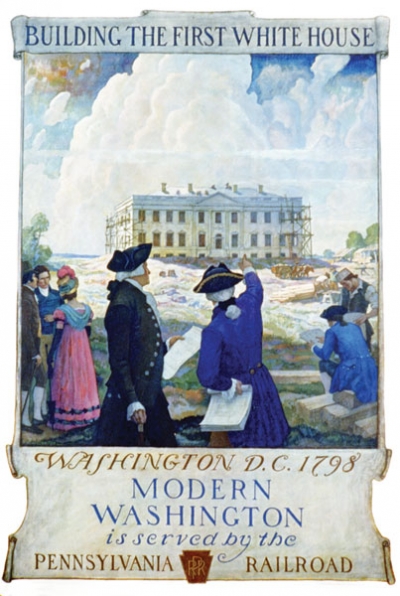
The story begins in the late 1920s when Ivy L. Lee, an independent publicist working for the Pennsylvania Railroad (PRR), commissioned famed illustrator N. C. Wyeth to paint twelve images of patriotic subjects, each related to a location served by the railroad. Lee had been impressed with the artistic quality and effectiveness of contemporary advertising posters issued by European railroads (many of which also are in the Hoover collection), and he hoped Wyeth’s designs would contribute to a higher American standard when displayed in stations, libraries, chambers of commerce, and schools. Lee also planned to publish the designs in Building the Nation, a booklet prepared by historian Hendrick Van Loon, which would link the Pennsylvania Railroad with the country’s growth and emphasize the railroad’s own development as a national institution.
The advertising poster that survives in the Hoover Archives and other collections offers the only way to see what the painting looked like.
By the late 1920s, Newell Convers Wyeth held a solidly established reputation as one of the country’s foremost illustrators. His career began at the turn of the century, just as rapid expansion in the publishing industry and technological advances in printing made possible a phenomenal increase in the number of color reproductions that appeared in magazines and books. With a keen sense of color, Wyeth used his palette and his lush painterly style to create larger-than-life heroes and villains featured in the short stories and novels of the day. His cowboys, American Indians, knights, and pirates, all depicted with his own brand of realism and romanticism, caught the reading public’s fancy. "Illustrated by N. C. Wyeth" became a guarantee of first-rate artistry.
During the second decade of the twentieth century, Wyeth contributed illustrations to a series of children’s classics for Charles Scribner’s Sons; his depictions of Robert Louis Stevenson’s characters in Treasure Island and Kidnapped became iconic classics in themselves. But Wyeth grew frustrated with the constraints of his profession, even as changing fashions in both literature and illustration caused the artist to seek new sources of income. In the 1920s, he continued to illustrate while moving successfully into mural painting and advertising. The railroad commission no doubt appealed to Wyeth for several reasons: during the First World War he had designed a number of well-received posters for the government and the Red Cross, and he nurtured a lifelong, vital interest in American history.
Beginning in late 1929 and throughout 1930, Wyeth produced the first three paintings in the PRR series: Ringing Out Liberty (Philadelphia), In Old Kentucky, and Pittsburgh in the Beginning. Building the First White House was the fourth. The Mutual Magazine (April 1932), a publication of the PRR, contained Wyeth’s description of the image:
President Washington’s interest in the erection of the building was constant throughout the years he served in office. . . . It is known that he made occasional visits to the new building. . . . And so I have chosen to picture one of these. . . . It is a day in the early summer of 1798, about the time that the slates for the roof were being laid. Mr. Washington stands beside architect Hoban, both intent upon some question concerning the building. At the left is a group of visitors, friends perhaps of Washington. On the right, two of Mr. Hoban’s assistants.
The historical details in every such Wyeth picture derived from his extensive research. He used a photographic reproduction of Hoban’s original drawing for the White House as the basis for the appearance of the building. Moreover, his Chadds Ford, Pennsylvania, studio library contained John Marshall’s five-volume Life of George Washington and several dozen gravure reproductions of paintings of the president; a full-size plaster cast of a bust of Washington also stood in the studio.
N. C. Wyeth’s illustrations for classics like Treasure Island and Kidnapped became classics in themselves.
Wyeth kept no daybooks and the painting is not mentioned in his extensive correspondence, but a reproduction of the poster featured in the November 1931 issue of Advertising Art suggests the painting was completed earlier that year.
As the nation’s financial situation worsened in the early 1930s, it is likely that the railroad canceled plans for the remainder of the project, including the book by Van Loon. Building the First White House was the last painting Wyeth produced for the series. In 1932, the four images were reproduced in a calendar issued by the Forbes Lithograph Manufacturing Company of Boston, which had printed the 41-by-27-inch posters, and in 1944 Building the First White House was reproduced in a textbook. These reproductions were credited to the PRR, the probable owner of all four paintings.
Interest in Wyeth’s work waned after his death in 1945 (ironically, caused by an accident at a Pennsylvania Railroad crossing near his home). In the late 1940s, a Delaware collector attempted to catalog Wyeth reproductions, not actual paintings, but his research notes suggest he failed to contact the railroad, an action that might have elicited some comment on the original artwork. The PRR merged in the late 1960s with the New York Central, faced bankruptcy in the early 1970s, and was later overtaken by Amtrak and Conrail, which itself was divided in the late 1990s. Commercial artwork was not among the most valued assets in any of these transactions. The Wyeth paintings disappeared.
"It is a day in the early summer of 1798, about the time that the slates for the roof were being laid," runs Wyeth’s description of his painting. "Mr. Washington stands beside architect Hoban, both intent upon some question concerning the building."
In 1990, the Wyeth Foundation for American Art funded a project at the Brandywine River Museum in Chadds Ford, Pennsylvania, to identify and locate every painting in Wyeth’s oeuvre. N. C. Wyeth, Catalogue Raisonné of Paintings was published in May 2008, and during the course of the research, no concrete information on the PRR paintings surfaced. As curator of the project, I searched through almost four decades of letters to the Brandywine River Museum from owners of paintings by N. C. Wyeth, and an even larger cache of similar letters sent to Andrew Wyeth, N. C.’s more famous son. These letters contained information on hundreds of paintings, but none mentioned Building the First White House or the three other PRR paintings. Auction catalogs and sales records were searched to no avail; telephone inquiries and letters were addressed to executives and attorneys in various departments of Penn Central and Conrail, again without turning up even a creditable lead.
In the late 1990s, I met Charles H. Wolfinger, who, after a long career with the PRR, the Lehigh Valley and Penn Central Railroads, and Conrail, had devoted some of his retirement to searching for the lost paintings. Wolfinger led me to correspondence in the Pennsylvania State Archives relevant to the Wyeth commission. He and I co-wrote an article on the paintings for The Keystone (spring 2001), a magazine published by the Pennsylvania Railroad Technical and Historical Society, hoping that the publicity would bring forth new information. A possible clue surfaced: John Cuddy, a Philadelphia-based ephemera dealer, provided me with a copy of a catalog produced for the 1972 public sale of "Railroad Relics, Artifacts, Rare and Historic Documents comprising the Entire Memorabilia of the Pennsylvania Railroad Museum." Most of the lot numbers between 1,783 and 1,877 are described as "framed paintings" . . . but the Wyeth canvases are not there.
Companies that commissioned such artwork often let executives decorate their offices with the paintings, and the executives took them when they retired. But no one has ever acknowledged owning this Wyeth.
Not surprising, Building the First White House has long been of interest to curators at the White House as well. In 1971 it was used on President Nixon’s Christmas card, reproduced from a poster in the Smithsonian collection. Subsequent proposals to use the image on a Christmas ornament and a postage stamp initiated further, and futile, searches for the original painting. In the Office of the Curator at the White House is another log of telephone calls and correspondence that have yielded no specific information on the original painting.
Where can the missing White House be? The possibilities are few. A number of Wyeth’s paintings were intentionally or accidentally destroyed, and such may have been the fate of Building the First White House. It is also possible that the four PRR paintings slipped quietly away: companies that commissioned such artwork often allowed executives to decorate their offices with the paintings, and when the executives retired they were given the paintings or simply took the artwork—by then dingy and forgotten—when they left. But the silence is strange. Sale prices for N. C. Wyeth’s work have risen to record levels during the past fifteen years—yet not a single one of the railroad paintings has been sold publicly.
Perhaps Building the First White House is still out there somewhere, in an attic or a warehouse, a mystery not to be solved until a future president is in office.








